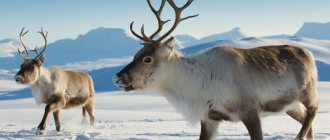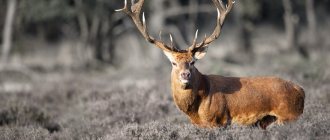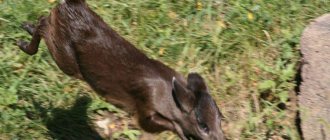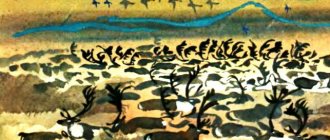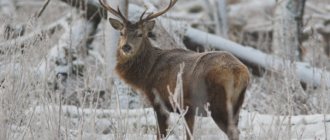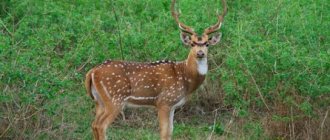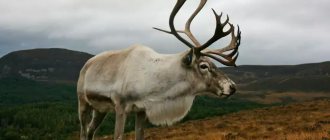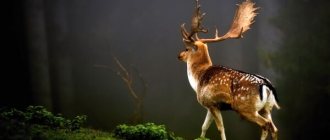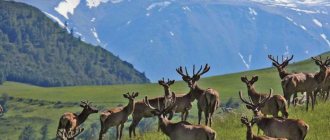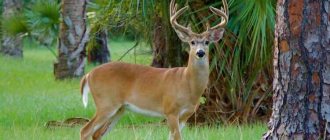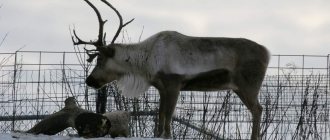Recently, representatives of the Great Smoky Mountains National Park (USA) published a photograph of a deer with bloody antlers. You might think that the animal is suffering from a serious illness, has become a victim of poachers, or has even attacked a defenseless person. But in fact, deer's bloody antlers are a natural phenomenon that even benefits them. In some photographs you can see that the animals are happily licking their own blood. Many temperate deer species shed their antlers and grow them back every year because they help them obtain food and reproduce. And this important process is accompanied by rupture of soft tissues, which are penetrated by blood vessels and nerves. But this is a very brief explanation of a phenomenon that is terrible at first glance, so I propose to consider it in more detail.
Deer with bloody antlers in the Great Smoky Mountains Park
Why do deer need antlers?
As a rule, only male deer grow antlers. Female reindeer also have such bone formations, but they are always smaller in size. Reindeer use their antlers to dig through snow as they hunt for moss, a lichen on which they feed. But most often, antlers are used by deer to eliminate rivals and attract the attention of females.
Antlers are commonly used by deer during fights.
Deer antlers constantly grow and, after reaching their maximum size, fall off. To get rid of old antlers, deer make sudden jumps. The rate of growth of horns directly depends on the metabolic processes in the animals’ bodies - the better they eat, the faster the horns grow. Individuals living in warm regions (closer to the equator) renew them every few years, while inhabitants of the temperate zone do this every year.
Antlers are an important part of the moose's hearing system.
Interesting fact: moose are the largest representatives of deer. They have poor eyesight, but a very developed sense of smell and hearing. It is believed that their huge horns are an important part of their hearing system.
Life of moose in their natural habitat
Moose lead an interesting lifestyle in terms of contact with each other. Thus, females unite in small groups and try to stay together, while males, on the contrary, prefer solitude, meeting females and other males only during the rutting period.
Read also: Beautiful background for text on Instagram
It’s hard to imagine without seeing it with your own eyes, but large, heavy moose can swim beautifully. Moreover, they spend a significant part of their lives in water, thus escaping mosquitoes and other blood-sucking insects. That is why animals prefer to settle in swampy areas, near water bodies.
From late summer to mid-autumn, moose go through the rut (“mating” period). At this time, it is better for a person not to come across the eyes of animals overwhelmed with feelings, as they become aggressive, less fearful and may well attack first. Competing with each other and attracting the attention of females, males make loud sounds like a roar and noisily break tree branches with their horns. It also happens that two males fight among themselves for a female, clashing their horns.
Moose cows bear their offspring for 8 months. As a rule, they give birth to 1-2 cubs, which they feed with milk for up to three months. On rich mother's milk, moose calves grow quickly and within a couple of weeks after birth they run after the herd, keeping up.
How are deer antlers renewed?
After shedding old antlers, deer begin to grow new ones. During the growth period they are called antlers and are covered with velvety skin. This layer is permeated with vessels and nerves, and its main task is to provide the horns with nutrients. At a certain point, deer begin to rub their new antlers against trees to tear the tissue covering them. If this is not done, the antlers will not be able to harden, but their strength directly affects the chances of defeating rivals and attracting the attention of females. When the skin tears, blood from the vessels begins to flow down the deer's antlers, which looks very scary from the outside. Some photos show deer licking this blood - in reality, they are simply eating the nutrient-rich skin. Don't let the goodness go to waste!
Some deer eat their own bloody flesh to obtain nutrients
Where does moose live?
Moose are common in the Northern Hemisphere. By the 19th century, the now numerous moose population was completely destroyed in Europe, excluding Russia, and only as a result of conservation measures taken at the beginning of the 20th century, these animals again settled in Northern and Eastern Europe. Now on the European continent, moose live in the countries of the Scandinavian Peninsula (Finland, Norway), in the north of Ukraine, in Belarus, Poland, Hungary, the Czech Republic, the Baltic countries (Latvia, Estonia), in Russia: from the Kola Peninsula in the north to the southern steppes. In Asia, they occupy the taiga zone of Siberia, reaching the forest-tundra, as well as the Far East, northeast China, and northern Mongolia. In North America, moose live in Canada, Alaska and the northeastern United States.
Diversification
The diversity of antlers, body sizes, and tusks has been greatly influenced by changes in habitat and behavior (fighting and mating).[13]
Capreoinae
- Porcupine caribou
- A mule is a deer with relatively large antlers
- White-tailed deer
- Pudu
Cervinae
- Irish elk are now extinct
- Young red deer, with velvet
- Doe
- American moose, or wapiti
- Sambar deer with thick forked beams instead of antlers.
- Read
Recommendations
- "Arctic Wildlife - Center for Arctic Research." naturalhistory.si.edu
. Archived from the original on May 1, 2022. Retrieved May 1, 2018. - Love, Heather “What is the difference between antlers and antlers?” Moment of Science - Indiana Media
. Retrieved 2020-12-05. - Brown, Leslie (1993). The New Short Oxford English Dictionary, Volume 1
. Clarendon Press. ISBN 0-19-861271-0. - ^ a b
Harper, Douglas (2010).
"Internet etymological dictionary". Dictionary.com
. Archived from the original on November 8, 2010. Retrieved 2010-11-08. - "horn". CollinsDictionary.com.
Collins English Dictionary - Complete and Unabridged 11th Edition. Retrieved October 27, 2012 . Archived from the original October 28, 2012 - "Dictionary.com Unabridged." Dictionary.com
. 2010. Archived from the original on November 8, 2010. Retrieved 2010-11-08. - ^ a b c d
Hall, Brian K. (2005).
"Horns". Bones and Cartilage: Evolutionary and Developmental Biology of the Skeleton
. Academic press. pp. 103–114. ISBN 0-12-319060-6. Retrieved 2010-11-08. - Horned Doe Archived February 29, 2012 Wayback Machine
- "Mammals: Pronghorn." San Diego Zoo. Retrieved 2013-06-27.
- ^ a b c d
Malo, A. F.;
Roldan, E.R.S.; Garde, J.; Soler, A. J.; Gomendio, M. (2005). “Horns honestly advertise sperm production and quality.” Proceedings of the Royal Society B: Biological Sciences
.
272
(1559): 149–57. doi:10.1098/rspb.2004.2933. PMC 1634960. PMID 15695205. - ^ a b
Whitaker, John O.;
Hamilton, William J. Jr. (1998). Mammals of the Eastern United States
. Cornell University Press. item 517. ISBN 0-8014-3475-0. Retrieved 2010-11-08. - Ditchkoff, Stephen S.; Lochmiller, Robert L.; Masters, Ronald E.; Hoofer, Stephen R.; Boucher, Ronald A. Van Den (2007). "Major histocompatibility complex-related changes in secondary sexual characteristics of white-tailed deer (Odocoileus Virginianus): evidence for advertising good genes." Evolution
.
55
(3): 616–25. Doi:10.1111/j.0014-3820.2001.tb00794.x. PMID 11327168. S2CID 10418779. - ^ a b c
Gilbert, Clément;
Ropike, Anne; Khasanin, Alexander (2006). "Mitochondrial and nuclear phylogenies of Cervidae (Mammalia, Ruminantia): systematics, morphology and biogeography". Molecular phylogenetics and evolution
.
40
(1): 101–17. Doi:10.1016/j.ympev.2006.02.017. PMID 16584894. - ^ a b
Kruuk, Loeske EB.;
Slate, John; Pemberton, Josephine M.; Brotherstone, Sue; Guinness, Fiona; Clutton-Brock, Tim (2002). "Red deer antler size: heredity and selection, but without evolution." Evolution
.
56
(8):1683–95. Doi:10.1111/j.0014-3820.2002.tb01480.x. PMID 12353761. S2CID 33699313. Archived (PDF) from the original dated September 16, 2016. - ^ a b
Perez-Gonzalez, J.;
Carranza, J.; Torres-Porras, J.; Fernandez-Garcia, J. L. (2010). "Low heterozygosity for microsatellite markers in Iberian small-antlered red deer." Journal of Heredity
.
101
(5):553–61. doi:10.1093/jhered/esq049. PMID 20478822. - ^ a b
Metz, Matthew C.;
Emlen, Douglas J.; Stahler, Daniel R.; MacNulty, Daniel R.; Smith, Douglas W. (2018-09-03). "Predation shapes the evolutionary traits of cervid arms." Nature Ecology and Evolution
.
2
(10): 1619–1625. Doi:10.1038/s41559-018-0657-5. PMID 30177803. S2CID 52147419. - Schaefer and Mahoney (December 2001). "Antlers on female caribou: a biogeography of bones of contention." Ecology
.
82
(12):3556–3560. Doi:10.2307/2680172. JSTOR 2680172. - ^ a b
Melnitsky;
and others. (December 2013). "Scaling of antler size in reindeer (Rangifer tarandus): sexual dimorphism and variability in resource allocation" (PDF). Journal of Mammology
.
94
(6):1371–1379. Doi:10.1644/12-mamm-a-282.1. S2CID 86047535. Retrieved November 13, 2016. - "Moose as a pet." Kostroma moose farm. Archived from the original dated 12/10/2016.
- Bubenik, Georgy A.; Bubenik, Peter G. (2008). “Moose palm antlers can serve as a parabolic sound reflector.” European Journal of Wildlife Research
.
54
(3):533–5.
doi:10.1007/s10344-007-0165-4. S2CID 44737101. Fold Resume – Guardian
(March 20, 2008). - ^ a b c
Heckeberg, Nicola S. (February 18, 2022).
"Systematics of Cervidae: an integrated evidence-based approach." PeerJ
.
8
:e8114. doi:10.7717/peerj.8114. ISSN 2167-8359. PMC 7034380. PMID 32110477. - Garrod A. Notes on the visceral anatomy and osteology of ruminants, with a proposal for a method of expressing relationships by formulas. Transactions of the Zoological Society of London, 2–18 (1877).
- Brook W. On the classification of Cervid with a synopsis of existing species. Journal of Zoology 46, 883–928 (1878).
- Pocock, R. Homologies among the antler lineages of Cervidae based on dichotomous growth theory. Journal of Zoology 103, 377–406 (1933).
- Samejima Y., Matsuoka H. A new look at antlers reveals the evolutionary history of deer (Cervidae, Mammalia). Scientific Journal 10, 8910 (2020). https://doi.org/10.1038/s41598-020-64555-7
- ^ a b
George A. Feldhamer;
William J. McShea (January 26, 2012). Deer: Animal Questions Answered
. JHU Press. P. 32–. ISBN 978-1-4214-0387-8. - Dennis Walrod (2010). Antlers: A Guide to Collecting, Counting, Mounting, and Carving
. Stackpole Books. paragraph 46. ISBN 978-0-8117-0596-7. - Bauer, Erwin A.; Bauer, Peggy (2000). Horns: Nature's Majestic Crown
. Voyageur Press. pp. 20–1. ISBN 978-1-61060-343-0. - Laskov, Sarah. "Horn Farm" Average (service)
. Archived from the original on September 3, 2014. Retrieved August 28, 2014. - "Wildlifeonline - Questions and Answers - Deer." Archived from the original January 15, 2012. Retrieved March 1, 2012.
- Fieldsport Britain. "Fieldsports Britain: Grouse on the Glorious Twelfth, roe deer and". fieldsportschannel.tv. Retrieved October 30, 2012.
- Dennis Walrod (2010). Antlers: A Guide to Collecting, Counting, Mounting, and Carving
. Stackpole Books. pp. 44–52. ISBN 978-0-8117-0596-7. - Dennis Walrod (2010). Antlers: A Guide to Collecting, Counting, Mounting, and Carving
. Stackpole Books. pp. 46–47. ISBN 978-0-8117-0596-7. - Susan Quinlan (November 18, 2011). “Parks Canada reminds visitors to look but not touch.” Prairie Post West
. p. 3. Archived from the original dated February 6, 2015. Received December 5, 2011. - Bauer, Erwin A.; Bauer, Peggy (2000). Horns: Nature's Majestic Crown
. Voyageur Press. clause 7. ISBN 978-1-61060-343-0. - Balikci, Asen (1989). Netsilik Inuit
. Waveland Press. pp. 38–39. - "Bow, case, arrows and quiver." Brooklyn Museum
. - "Archival copy." In the archive from the original dated 03/08/2012. Retrieved 2012-07-06.CS1 maint: archived copy as title (link)[ full citation required
] - . Archived from on 2011-07-25. Retrieved 2011-01-15.CS1 maint: archived copy as title (link)[ full citation needed
] - "Velvet Antler Deer - Research Summary." www.vitaminsinamerica.com
. Archived from the original October 18, 2022. Retrieved May 1, 2018. - DiSalvo (2015-9-18). How to squeeze snake oil out of deer antlers and make millions. [1] forbes.com
- Slivert, G; Burke, V; Palmer, S; Walmsley, A; Gerrard, D; Haines, S; Littlejohn, R. (2003). "Effects of Deer Antler Extract or Powder Supplementation on Aerobic Power, Erythropoiesis, and Muscle Strength and Endurance." International Journal of Sports Nutrition and Exercise Metabolism
.
13
(3): 251–65. Doi:10.1123/ijsnem.13.3.251. PMID 14669926.
This article incorporates text from a publication now in the public domain: Chambers, Ephraim, ed. (1728). Cyclopædia, or Universal Dictionary of Arts and Sciences
(1st ed.). James and John Knapton et al Missing or Blank | title = (help)
